
by Birgitte Rasine |
We humans have been telling stories since we learned to talk. No doubt those tales that sent torrents of adrenaline through our veins also seared the strongest tracks in our memory, and were told and retold through generation after iPad-less generation. Indeed, the definition of myth is “a traditional story, especially one concerning the early history of a people or explaining some natural or social phenomenon, and typically involving supernatural beings or events.”
So where do you draw the line between a myth and a fictional story?
You don’t. You write one into the other.

by Liz Bureman |
On Saturday, I went out to dinner with some friends as an early birthday celebration. We all ate our fill, and when the server came by to ask us how we felt about dessert, all of us laughed because we were so full. Sweet treats to follow? Please.
Speaking of desserts, I’m sure we all know the different between a desert and a dessert, right? Just in case, let’s review.

by Joe Bunting |
I consider myself primarily a creative writer, but to pay the bills, I take on many the odd job involving writing. Because of that, I’ve been doing a lot of editing lately, editing blog posts, articles, books, and more.
With all this editing, I’ve found that I keep making several of the same changes again and again. Yes, there are typos and grammatical corrections, but a surprising amount of the editing I have to do is just simple formatting.
by Liz Bureman |
I’ve recently discovered that whenever I think something is great or fantastic, and it’s worth commenting on how great or fantastic it is, I default to the exact same word in every conversation. It’s “awesome”. Everything is awesome.
If it’s funny, it’s awesome. If it’s pretty, it’s awesome. If it makes you think, it’s awesome. If it’s a weird random fact, it’s awesome. It’s funny because most of the time, I speak in SAT words.

by Liz Bureman |
I was talking to a friend the other night, and somewhere in the conversation we started making guesses about where the rest of our crew was at that point in the night. I started to say, “I assume…” but then I stopped myself and had a second guess moment. “Assume? Presume? Which one is it?” Obviously since we live in the age of smartphones and instant Google, I looked it up. Believe it or not, there is a slight difference, and I’m sharing it with you today.

by Liz Bureman |
Over the weekend, Joe sent me a link to a blog that talks about how students are apparently saying “all of the sudden” instead of “all of a sudden”. Is that a thing? It was actually the first time I’d heard of the words in idioms being switched around. In case there was any confusion, “all of the sudden” is incorrect, “all of a sudden” is correct, and whoever created the idiom made it a completely arbitrary decision.







